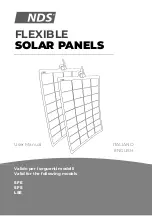
29
Solar System Installation Guide
System Check
If the sun is out, then it is possible to check the system function. If not, a time the following day should be scheduled to
make sure the system is operating properly. Make sure to switch the controller to automatic mode (see page 28). This
will activate the pump when the temperature conditions are met. The following things should be checked:
1.
Check all temperature sensors are reading values that make sense. The collector sensor should climb when the
pump is not activated.
2.
Verify that the flow rate of the pump station is correct as the temperature in the solar loop rises. The flow rate
will decrease slightly when the temperature becomes higher. If the flow of fluid stops and the pump is still
running, there could be an air bubble in the system. Release all air from the trap and repurge the system.
3.
Verify the controller switches the system on when the temperature conditions are met (see page 23).
4.
Check both air vents for buildup of air. Air will come out of the glycol solution as the temperature of the fluid
increases.
5.
Verify that the system pressure is maintained. If a large quantity of air does come out of the system, this will
cause the system pressure to drop significantly. The system will need to be repurged if this occurs.
6.
Check all connections for any sign of leakage. Even a tiny drip is unacceptable, since this is a closed system and
will eventually cause a loss of pressure within the system.
7.
Verify that all roof penetrations are waterproof and the collector is firmly mounted to the roof.
It is a good idea to arrange a visit about a week after the system has been commissioned in order to verify that the
system is still working properly. As air works its way out of the system, the pressure may drop. Because it takes hot
liquid for this to occur fully, it is best to check on the system several times and bleed air after it has been commissioned.
Leaving System Unused
Your Thermomax system requires no special attention if you are going to be gone for short periods of time. For
extended periods where there will be no demand for hot water, it is recommended to have your installer remove the
tubes from the collector until the system is going to be used again. Besides this, there are no other special
considerations.
Decommissioning the System
Due to temperatures potentially of very high temperatures and pressures, a solar installation should only be
decommissioned by a trained individual. The system should be decommissioned in low light, ideally in the morning
when the solar loop should be coolest.
Electrical
Turn breaker for the solar system to the off position. Verify there is no voltage at the controller before proceeding.
Remove cables to controller and pump
Remove sensors and associated cables
Remove grounding cables
Collector Loop
Beware of hot transfer fluid
Drain collector loop at drain valve. Contain the heat transfer fluid for appropriate disposal.
Disconnect pipes from the manifold
Collector (Beware of high temperatures)
Remove rubber retainer to release manifold lid
Unclip tube








































